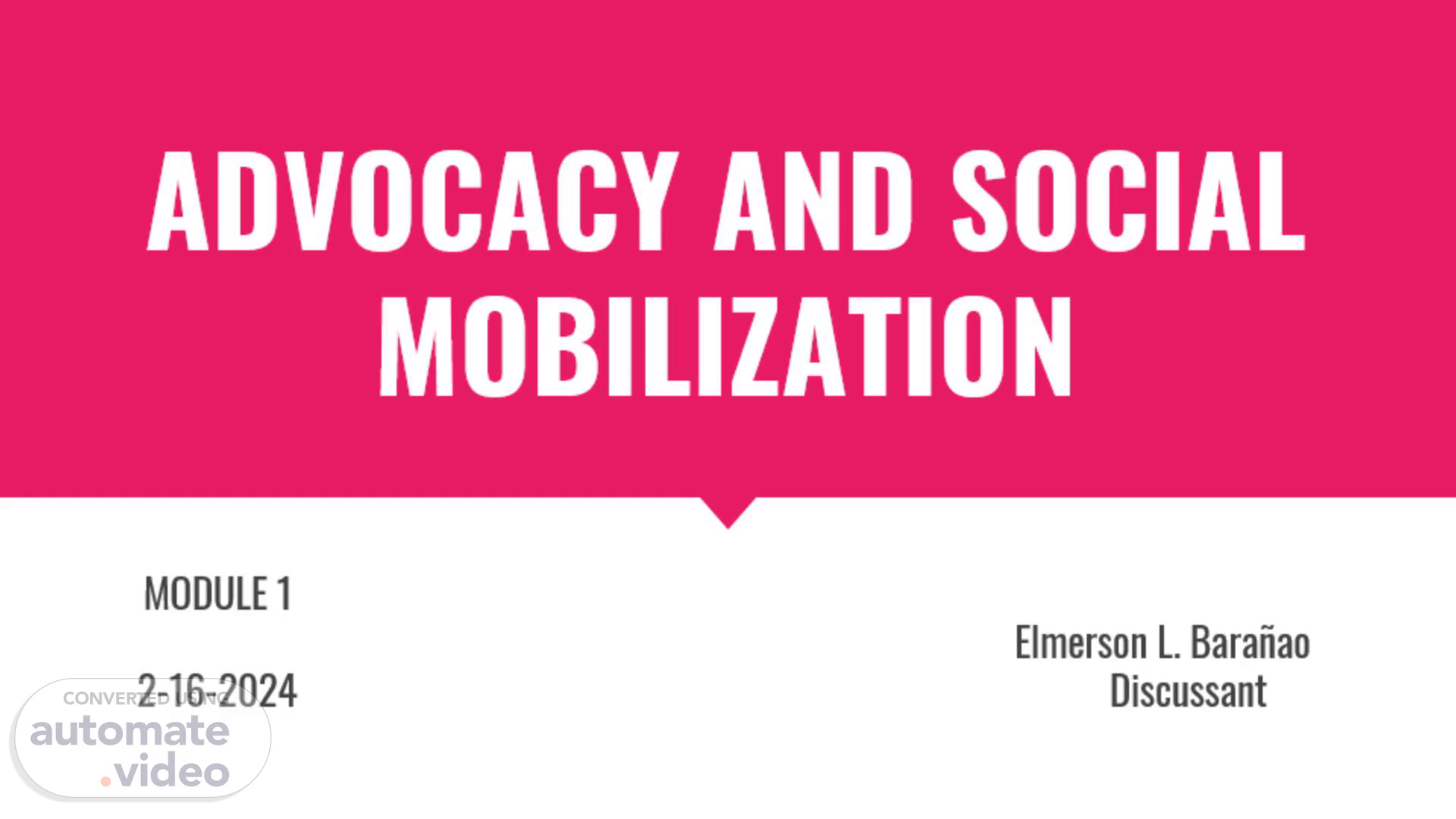
Page 1 (0s)
[Audio] Good day everyone! Today we will talk about ADVOCACY AND SOCIAL MOBILIZATION , I am your presenter Mr. Elmerson L. Baranao.
Page 2 (9s)
[Audio] Module 1 Topic 5: Advocacy and Social Mobilization its Differences and Relationship Module Objectives: At the end of the module, you should be able to: 1. Discuss the following concepts: advocacy, communication and social mobilization and other related concepts 2. Illustrate/Describe a concept map showing the relationship among these concepts..
Page 3 (38s)
[Audio] ADVOCACY Advocacy' is a broader term that encompasses a range of practices, from awareness-raising through to community mobilization campaigns. Advocacy is the core activity of all social movements: the "act of persuading or arguing in support of a specific cause, policy, idea or set of values" (Cox & Pezzullo, 2016, p.177)..
Page 4 (1m 3s)
[Audio] Advocacy works primarily to change the behavior of public leaders or decision-makers. Advocacy, like all forms of public interest communication, takes place in complex, dynamic discourse arenas. These arenas include the social environments and physical settings where advocates' interactions with other individuals and groups generate particular decisions or outcomes (Jasper, 2019)..
Page 5 (1m 29s)
[Audio] It is when individuals come together and advocate for change on a particular shared cause, that a social movement is formed. Other components of these social movements include campaigns, tactics and outcomes. Advocacy 'works' when advocates are able to persuade others that their cause is just. It is not about competition; but instead about the ability of different public interest groups to engage the goals and interests of other players in the arena (Jasper & Duyvendak, 2015)..
Page 6 (2m 1s)
[Audio] BEST PRACTICE OF ADVOCACY Best practice advocacy begins with a clear and realistic 'ask' supported by evidence. That ask is most effective when it represents community sentiment. Generally, advocacy strategies and campaigns aim to influence: funding and resources infrastructure priorities policy change process change.
Page 7 (2m 28s)
[Audio] Levels of Advocacy Self, Individual, Systematic.
Page 8 (2m 41s)
[Audio] Why do you need to advocate? Advocacy is required when there's a clearly identifiable and pressing need or issue that you (as a local government) can't respond to on your own or is the responsibility of another level of government. Community advocacy activities and campaigns may be part of a short, mid, or long-term strategy, or may represent an urgent and emerging need..
Page 9 (3m 9s)
[Audio] The Network Advocacy Arena Other advocacy groups offer an important source of support, whether financial, emotional or practical. Gaining support from other advocacy groups enable strong and sustainable coalitions, which can increase advocates ability to gain power and achieve their goals (Tarrow & Tilly, 2007). Groups within the advocacy network arena can include NGOs, other grassroots groups focusing on similar causes, identity groups such as religious or ethnic groups, or trans-national advocacy organisations and coalitions. This arena can be a positive source of support for groups as well as an ongoing challenge; the formation and dissolution of like-minded coalitions is a constant feature of social movement dynamics..
Page 10 (3m 57s)
[Audio] SOCIAL MOBILIZATION Social mobilization is the process of bringing together allies to raise awareness of and demand for a particular program to assist in the delivery of resources and services and to strengthen community participation for sustainability and self-reliance.
Page 11 (4m 18s)
[Audio] ALLIES "Allies" include decision- and policy-makers, opinion leaders, NGOs such as professional and religious groups, the media, the private sector, communities and individuals. Social mobilization generates dialogue, negotiation and consensus, engaging a range of players in interrelated and complementary efforts, taking into account the needs of people.
Page 12 (4m 44s)
[Audio] KEY ELEMENTS OF SOCIAL MOBILIZATION 1. Partnership building and networking 2. Community participation 3. Media and special events to raise awareness 4. Advocacy to mobilize resources and effect policy change.
Page 13 (5m 1s)
[Audio] 5 MAIN APPROACHES TO SOCIAL MOBILIZATION 1. POLITICAL MOBILIZATION 2. COMMUNITY MOBILIZATION 3. GOVERNMENT MOBILIZATION 4. CORPORATE MOBILIZATION 5. BENEFICIARY MOBILIZATION.
Page 14 (5m 18s)
[Audio] DIFFERENCES. DIFFERENCES. Approach PoliticallGovernment mobilization Community mobilization Corporate mobilization Client mobilization Targets National policymakers, government officials, or agencies Local political, religious, social leaders; NGOs; women's groups; etc. National or intemational companies (to carry appropriate messages, product labeling) Activities Lobbying, meetings Community meetings, mass media, celebrity events, World AIDS Day Meetings, mass media Trainings, support TB patients, family members groups, mass media.
Page 15 (5m 45s)
[Audio] Activity Recall an advocacy or social mobilization activity you joined/participated and share key points/strategies used. Approach Target(s) Activities Outcomes.